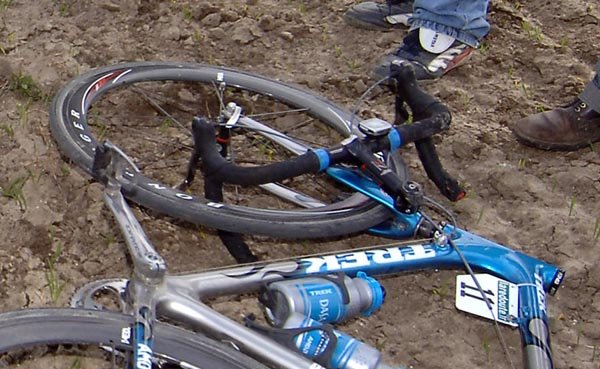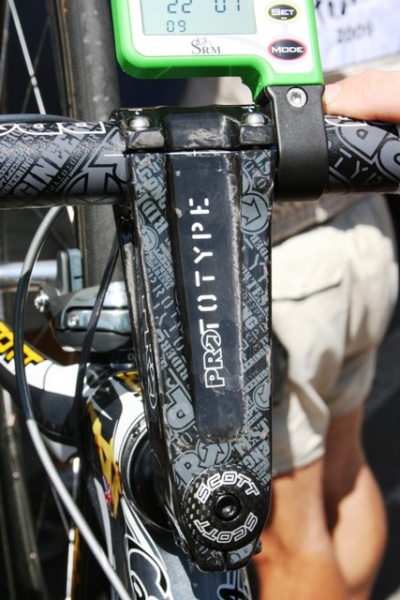I’ve watched Jens Voigt’s crash on TdF stage 16 no less than 30 times, and while it’s tempting to want to cry J’accuse! before those manufacturers of ultralight carbon components, I really can’t see any equipment failure.
Video removed.
If you watch the clip, you can see the rider in front of Voigt bounces on a change in the pavement. At almost the same instant, Voigt initiates a change in grip of his left hand, moving from the hood to the drop, probably in anticiapation of the curve ahead. Most pros feel more secure in the drops than on the hoods, but he hits the bump a millisecond later while his left hand is not securely on the bar. He hits the bump hard enough for his rear wheel to lose contact (you can see from the gap between his tire and its shadow), and he totally loses grip with his left hand. His weighted right hand ends up pushing his handlebar to the left, cocking the front tire patch slightly sideways into the white line. The front wheel contact goes unstable, and the front of the bike washes out underneath Voigt. With his center of gravity pitched forward from the bump, he goes down face first into a 40mph belt sander.
The crash was not initiated by equipment failure. Even after the crash, the wheel, fork, crank, chain, and handlebar seem to be intact. Watching the clip, it’s clear that his feet are secure in the pedals at least to a point well beyond no return, so cleat failure is ruled out. Voigt just didn’t see it coming and had no chance to recover. Freaky, but it happens.
On the other hand, bikes do break and when they do it can bring down a lot of bad press to the companies who make them. Team boss Bjarne Riis was quick to point out that equipment failure had nothing to do with the crash; he has a responsibility to his equipment sponsors to represent them well. Yet teams and riders are always looking for an edge, and occasionally they choose components that aren’t suited to the task. Manufacturers are pushing the limits of design and materials; occasionally they cut the margins too thin.
There are 3 components that must never fail on a bike: handlebar, stem, and fork. If any of these fail, an ugly crash ensues.
George Hincapie’s famous fork failure during the 2006 Paris-Roubaix forced him to withdraw from the race with a broken clavicle, robbing him of one of his best chances to win a career-long goal. The aluminium steerer of his special Roubaix fork sheered between his stem and the top headset bearings, causing him to crash hard. Since this fork was a Trek prototype for the Discovery Channel team, not a whole lot can be said about the causes and ramifications of the failure. But on the surface, it sure looks bad. Forks shouldn’t ever break like that.
 (http://velonews.com/photo/34346) photo from Velonews
(http://velonews.com/photo/34346) photo from Velonews
Specialized should breathe a sigh of relief that their bike wasn’t the cause of Voigt’s crash. Voigt rides for Saxo Bank, which along with Quick-Step are the two Pro Tour teams using Specialized. When Specialized first started providing bikes to Quick-Step, the team bikes all had the stock Specialized forks discretely replaced with Time carbon forks. Rumour had it that riders and team mechanics insisted on the Time forks, that the stock forks couldn’t be trusted after even a minor crash. Today though it seems as if Saxo Bank and Quick-Step are both using Specialized forks. Of course, the newest Specialized Tarmac and Roubaix frames do require kooky tapered steerer tube forks to fit their head tubes, so it may be that a substitution may not be physically possible.
It’s almost de rigueur for le Tour that teams show up with the most expensive and lightest bikes, but some riders still specifically choose robustness over weight savings. As much as carbon fibre handlebars are marketed as light and stiff, many pro riders (but not all) insist on aluminium models. An alloy bar might merely bend in a crash that would break a carbon one, which may be the difference between finishing with the group and getting eliminated on time. Sprinter extraordinaire Mark Cavendish sports a carbon stem that’s as blocky as a bulldozer, but most likely he is using same alloy bar that he did at the Tour of California. And even the stem, originally developed by Shimano subsidiary “Pro” for track racing, is built for stiffness rather than lightness.

photo from Velonews
Wheels, particularly the front, are also pretty crucial. Take Mavic’s infamous R-Sys wheels, which for the esteemed French company has been a p.r. disaster. And I mean p.r. as in pubic relations disaster, not P-R for Paris Roubaix, because I don’t think even the bravest of sponsored riders want to leap into the Hell of the North astride tubular carbon spokes. The aged cobbles of Paris-Roubaix swallow gobs of wheels and spit them out in bits. Zipp-sponsored Garmin has suffered a lot of breakages of carbon rims that some say could have been avoided if they had ridden the traditional alloy rims favoured by most. Much like alloy handlebars, a bent rim might allow a rider to continue to the finish or at least to ride to a spot where the team car can conveniently swap out wheels. A cracked carbon rim can leave a rider watching the race ride away, stranded in the middle of a pave sector, a no man’s land away from team cars and mechanics.
The Tour de France is cycling’s biggest stage, not only for the likes of Armstrong and Contador, but also for Specialized and Trek, 3T and FSA, Time and Speedplay. A lot can be gained by being perceived as purveyor of winning bikes and bits, but a well-televised breakage could ruin the marketability of a product, sending mountains of development and marketing money down the crapper. Voigt seems to have been a victim of bad luck today, yet I wonder if there’s some rider cursing his equipment sponsor…but only when the tv camera isn’t pointed his way.
…We're riding townies, adventure, and mountain bikes. Find recommendations on our store page. As Amazon Associates we earn from qualifying purchases.